Etisalat Telecommunication Company: Change Management Report
VerifiedAdded on 2022/10/12
|23
|6902
|92
Report
AI Summary
This report provides a comprehensive analysis of strategic change management within Etisalat Telecommunication Company. It begins with an executive summary, followed by an introduction that defines change management and its importance. The report then provides an overview of Etisalat, highlighting the need for change driven by factors such as competition and technological advancements. It explores the implications of ignoring change requirements, emphasizing the impact on organizational performance and stakeholder relationships. The core of the report examines various change management models, including McKinsey's 7-S Model, Lewin's Change Management Model, and Kotter's 8-Step Change Model, explaining their application and benefits to Etisalat. It also discusses change interventions, change management strategies, stakeholder analysis, and communication strategies to overcome resistance. Finally, the report includes a change implementation plan, covering the nature and perspective of change, and concludes with recommendations for Etisalat's future growth and competitiveness, incorporating the Lewin and Kotter models to provide a robust framework for change implementation.
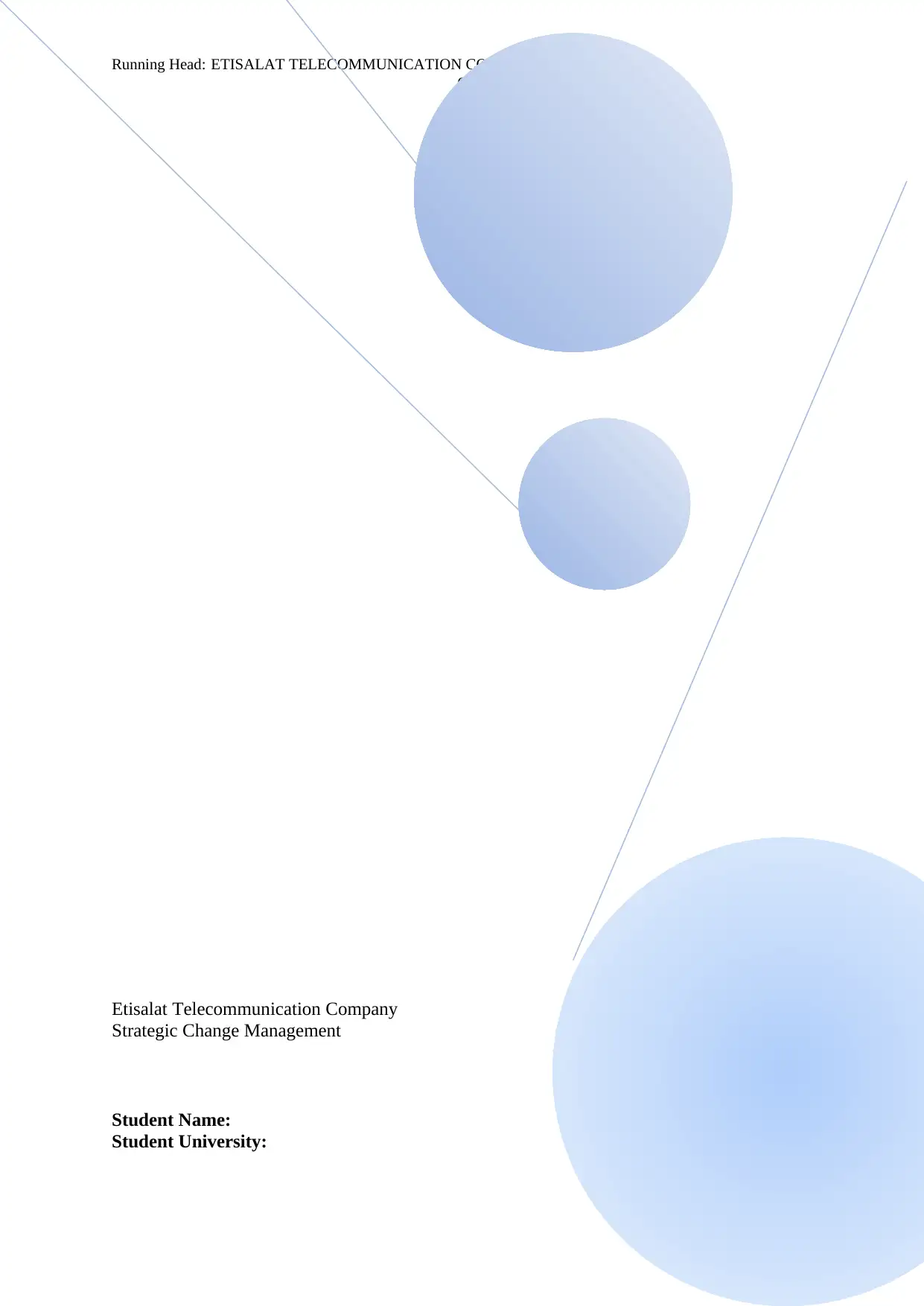
Running Head: ETISALAT TELECOMMUNICATION COMPANY
0
Etisalat Telecommunication Company
Strategic Change Management
Student Name:
Student University:
0
Etisalat Telecommunication Company
Strategic Change Management
Student Name:
Student University:
Paraphrase This Document
Need a fresh take? Get an instant paraphrase of this document with our AI Paraphraser
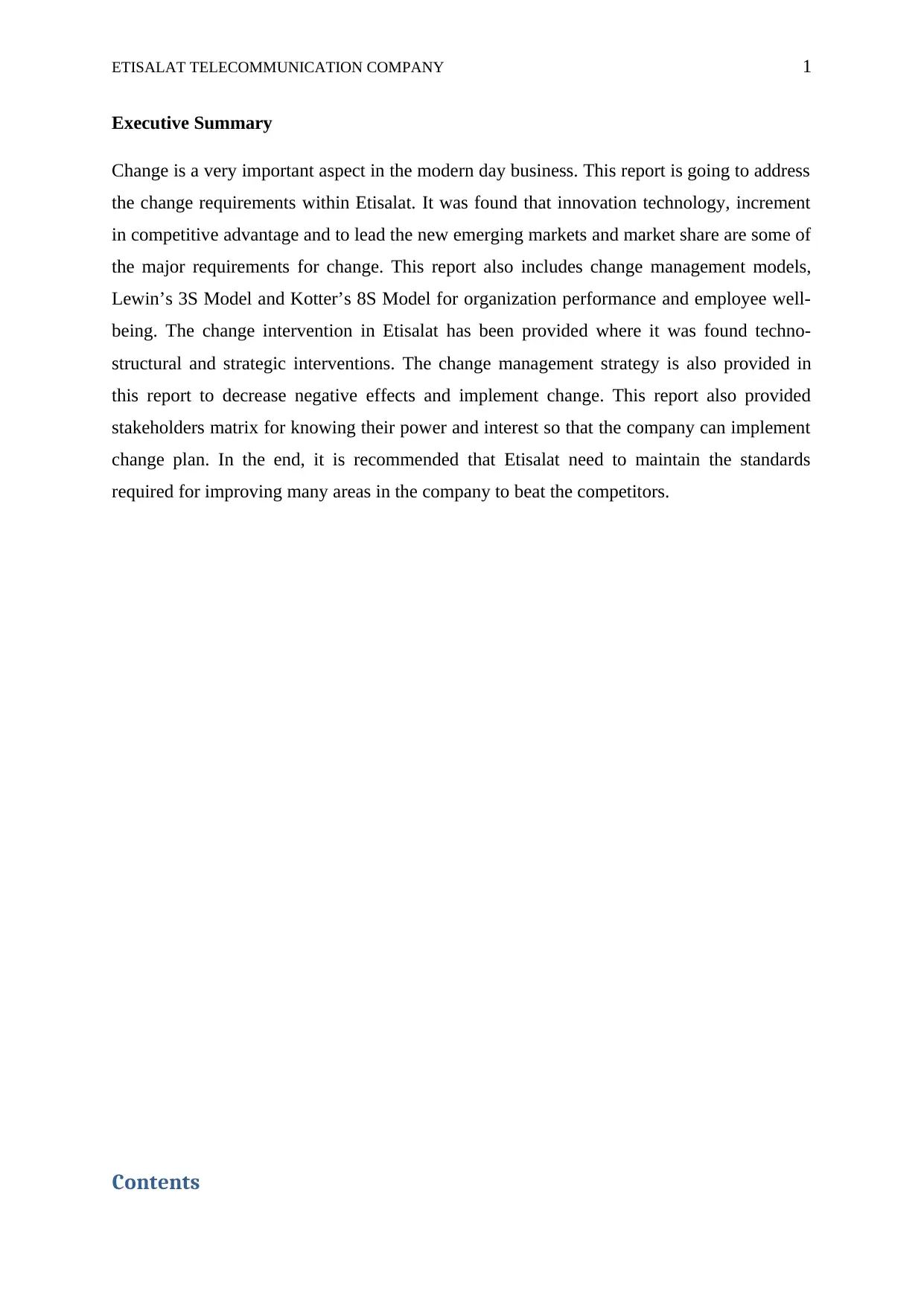
ETISALAT TELECOMMUNICATION COMPANY 1
Executive Summary
Change is a very important aspect in the modern day business. This report is going to address
the change requirements within Etisalat. It was found that innovation technology, increment
in competitive advantage and to lead the new emerging markets and market share are some of
the major requirements for change. This report also includes change management models,
Lewin’s 3S Model and Kotter’s 8S Model for organization performance and employee well-
being. The change intervention in Etisalat has been provided where it was found techno-
structural and strategic interventions. The change management strategy is also provided in
this report to decrease negative effects and implement change. This report also provided
stakeholders matrix for knowing their power and interest so that the company can implement
change plan. In the end, it is recommended that Etisalat need to maintain the standards
required for improving many areas in the company to beat the competitors.
Contents
Executive Summary
Change is a very important aspect in the modern day business. This report is going to address
the change requirements within Etisalat. It was found that innovation technology, increment
in competitive advantage and to lead the new emerging markets and market share are some of
the major requirements for change. This report also includes change management models,
Lewin’s 3S Model and Kotter’s 8S Model for organization performance and employee well-
being. The change intervention in Etisalat has been provided where it was found techno-
structural and strategic interventions. The change management strategy is also provided in
this report to decrease negative effects and implement change. This report also provided
stakeholders matrix for knowing their power and interest so that the company can implement
change plan. In the end, it is recommended that Etisalat need to maintain the standards
required for improving many areas in the company to beat the competitors.
Contents
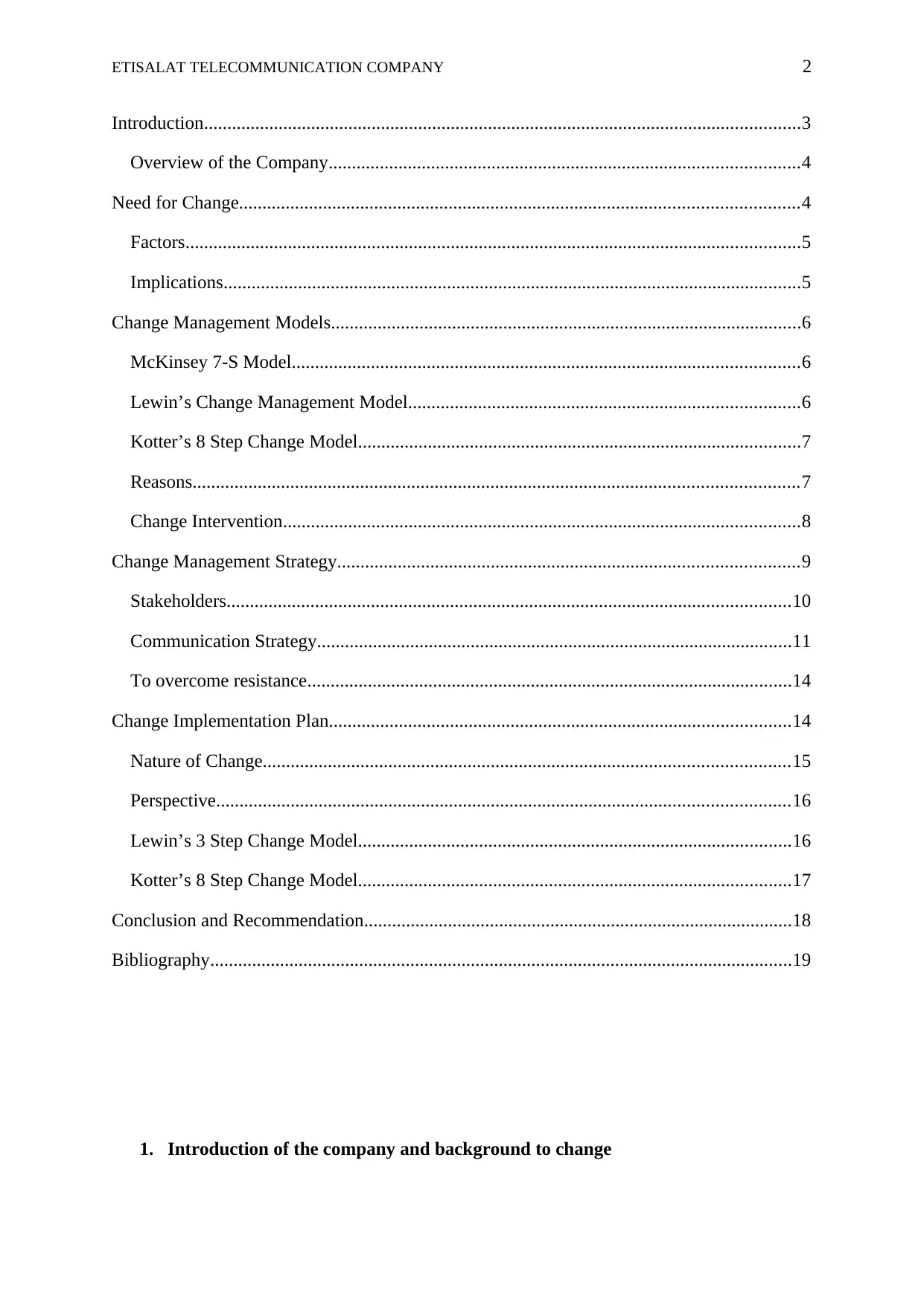
ETISALAT TELECOMMUNICATION COMPANY 2
Introduction................................................................................................................................3
Overview of the Company.....................................................................................................4
Need for Change........................................................................................................................4
Factors....................................................................................................................................5
Implications............................................................................................................................5
Change Management Models.....................................................................................................6
McKinsey 7-S Model.............................................................................................................6
Lewin’s Change Management Model....................................................................................6
Kotter’s 8 Step Change Model...............................................................................................7
Reasons..................................................................................................................................7
Change Intervention...............................................................................................................8
Change Management Strategy...................................................................................................9
Stakeholders.........................................................................................................................10
Communication Strategy......................................................................................................11
To overcome resistance........................................................................................................14
Change Implementation Plan...................................................................................................14
Nature of Change.................................................................................................................15
Perspective...........................................................................................................................16
Lewin’s 3 Step Change Model.............................................................................................16
Kotter’s 8 Step Change Model.............................................................................................17
Conclusion and Recommendation............................................................................................18
Bibliography.............................................................................................................................19
1. Introduction of the company and background to change
Introduction................................................................................................................................3
Overview of the Company.....................................................................................................4
Need for Change........................................................................................................................4
Factors....................................................................................................................................5
Implications............................................................................................................................5
Change Management Models.....................................................................................................6
McKinsey 7-S Model.............................................................................................................6
Lewin’s Change Management Model....................................................................................6
Kotter’s 8 Step Change Model...............................................................................................7
Reasons..................................................................................................................................7
Change Intervention...............................................................................................................8
Change Management Strategy...................................................................................................9
Stakeholders.........................................................................................................................10
Communication Strategy......................................................................................................11
To overcome resistance........................................................................................................14
Change Implementation Plan...................................................................................................14
Nature of Change.................................................................................................................15
Perspective...........................................................................................................................16
Lewin’s 3 Step Change Model.............................................................................................16
Kotter’s 8 Step Change Model.............................................................................................17
Conclusion and Recommendation............................................................................................18
Bibliography.............................................................................................................................19
1. Introduction of the company and background to change
⊘ This is a preview!⊘
Do you want full access?
Subscribe today to unlock all pages.

Trusted by 1+ million students worldwide
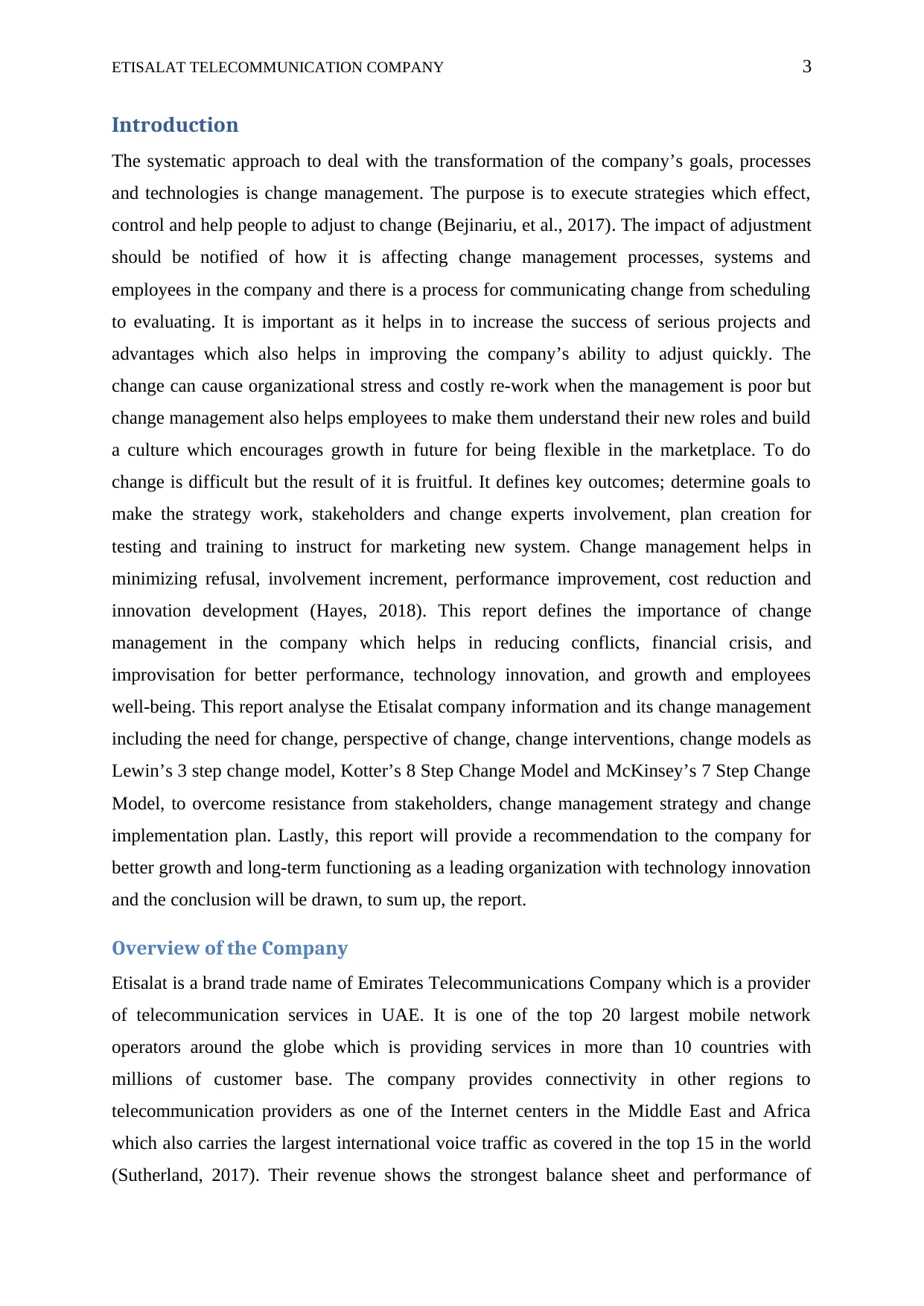
ETISALAT TELECOMMUNICATION COMPANY 3
Introduction
The systematic approach to deal with the transformation of the company’s goals, processes
and technologies is change management. The purpose is to execute strategies which effect,
control and help people to adjust to change (Bejinariu, et al., 2017). The impact of adjustment
should be notified of how it is affecting change management processes, systems and
employees in the company and there is a process for communicating change from scheduling
to evaluating. It is important as it helps in to increase the success of serious projects and
advantages which also helps in improving the company’s ability to adjust quickly. The
change can cause organizational stress and costly re-work when the management is poor but
change management also helps employees to make them understand their new roles and build
a culture which encourages growth in future for being flexible in the marketplace. To do
change is difficult but the result of it is fruitful. It defines key outcomes; determine goals to
make the strategy work, stakeholders and change experts involvement, plan creation for
testing and training to instruct for marketing new system. Change management helps in
minimizing refusal, involvement increment, performance improvement, cost reduction and
innovation development (Hayes, 2018). This report defines the importance of change
management in the company which helps in reducing conflicts, financial crisis, and
improvisation for better performance, technology innovation, and growth and employees
well-being. This report analyse the Etisalat company information and its change management
including the need for change, perspective of change, change interventions, change models as
Lewin’s 3 step change model, Kotter’s 8 Step Change Model and McKinsey’s 7 Step Change
Model, to overcome resistance from stakeholders, change management strategy and change
implementation plan. Lastly, this report will provide a recommendation to the company for
better growth and long-term functioning as a leading organization with technology innovation
and the conclusion will be drawn, to sum up, the report.
Overview of the Company
Etisalat is a brand trade name of Emirates Telecommunications Company which is a provider
of telecommunication services in UAE. It is one of the top 20 largest mobile network
operators around the globe which is providing services in more than 10 countries with
millions of customer base. The company provides connectivity in other regions to
telecommunication providers as one of the Internet centers in the Middle East and Africa
which also carries the largest international voice traffic as covered in the top 15 in the world
(Sutherland, 2017). Their revenue shows the strongest balance sheet and performance of
Introduction
The systematic approach to deal with the transformation of the company’s goals, processes
and technologies is change management. The purpose is to execute strategies which effect,
control and help people to adjust to change (Bejinariu, et al., 2017). The impact of adjustment
should be notified of how it is affecting change management processes, systems and
employees in the company and there is a process for communicating change from scheduling
to evaluating. It is important as it helps in to increase the success of serious projects and
advantages which also helps in improving the company’s ability to adjust quickly. The
change can cause organizational stress and costly re-work when the management is poor but
change management also helps employees to make them understand their new roles and build
a culture which encourages growth in future for being flexible in the marketplace. To do
change is difficult but the result of it is fruitful. It defines key outcomes; determine goals to
make the strategy work, stakeholders and change experts involvement, plan creation for
testing and training to instruct for marketing new system. Change management helps in
minimizing refusal, involvement increment, performance improvement, cost reduction and
innovation development (Hayes, 2018). This report defines the importance of change
management in the company which helps in reducing conflicts, financial crisis, and
improvisation for better performance, technology innovation, and growth and employees
well-being. This report analyse the Etisalat company information and its change management
including the need for change, perspective of change, change interventions, change models as
Lewin’s 3 step change model, Kotter’s 8 Step Change Model and McKinsey’s 7 Step Change
Model, to overcome resistance from stakeholders, change management strategy and change
implementation plan. Lastly, this report will provide a recommendation to the company for
better growth and long-term functioning as a leading organization with technology innovation
and the conclusion will be drawn, to sum up, the report.
Overview of the Company
Etisalat is a brand trade name of Emirates Telecommunications Company which is a provider
of telecommunication services in UAE. It is one of the top 20 largest mobile network
operators around the globe which is providing services in more than 10 countries with
millions of customer base. The company provides connectivity in other regions to
telecommunication providers as one of the Internet centers in the Middle East and Africa
which also carries the largest international voice traffic as covered in the top 15 in the world
(Sutherland, 2017). Their revenue shows the strongest balance sheet and performance of
Paraphrase This Document
Need a fresh take? Get an instant paraphrase of this document with our AI Paraphraser
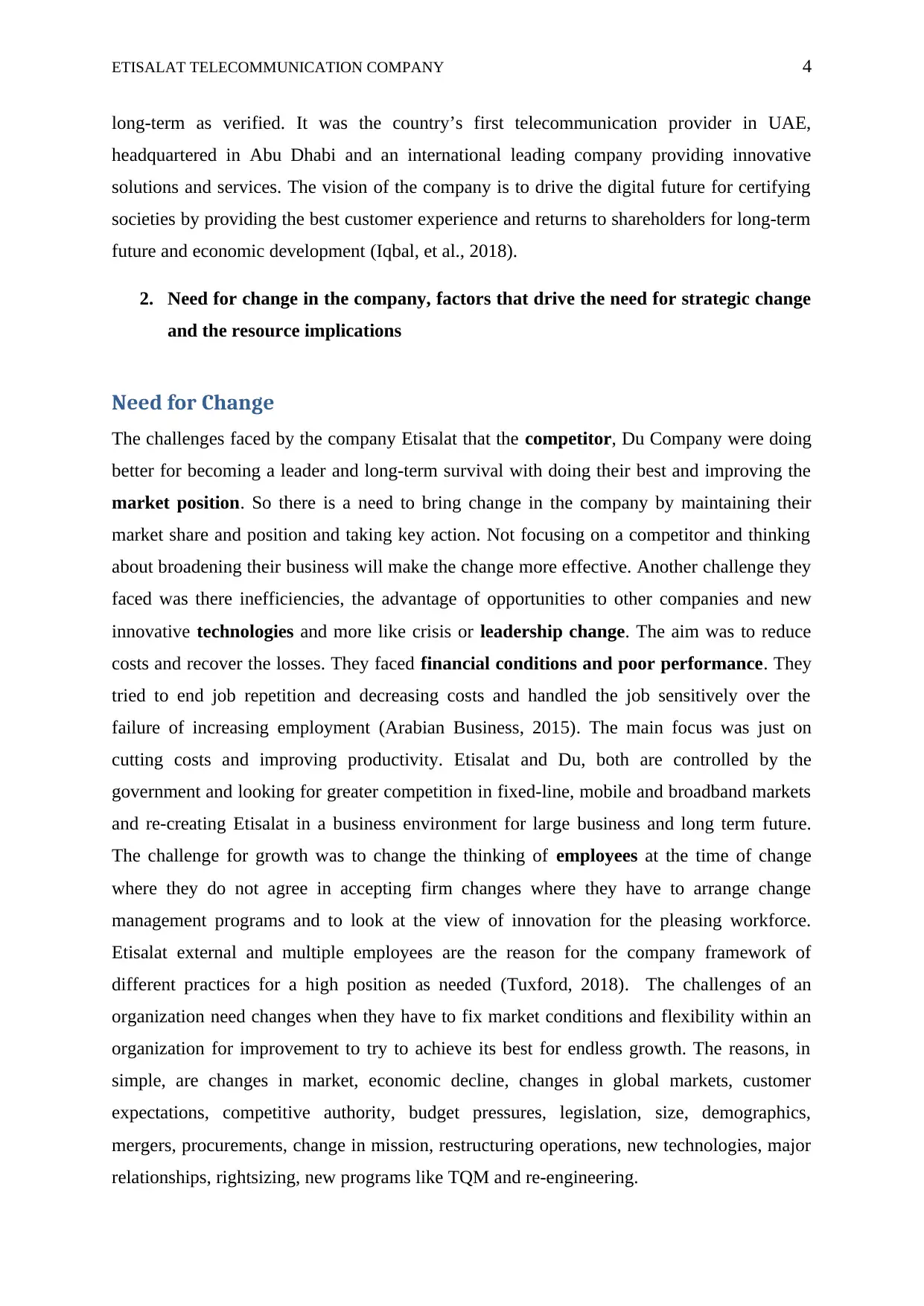
ETISALAT TELECOMMUNICATION COMPANY 4
long-term as verified. It was the country’s first telecommunication provider in UAE,
headquartered in Abu Dhabi and an international leading company providing innovative
solutions and services. The vision of the company is to drive the digital future for certifying
societies by providing the best customer experience and returns to shareholders for long-term
future and economic development (Iqbal, et al., 2018).
2. Need for change in the company, factors that drive the need for strategic change
and the resource implications
Need for Change
The challenges faced by the company Etisalat that the competitor, Du Company were doing
better for becoming a leader and long-term survival with doing their best and improving the
market position. So there is a need to bring change in the company by maintaining their
market share and position and taking key action. Not focusing on a competitor and thinking
about broadening their business will make the change more effective. Another challenge they
faced was there inefficiencies, the advantage of opportunities to other companies and new
innovative technologies and more like crisis or leadership change. The aim was to reduce
costs and recover the losses. They faced financial conditions and poor performance. They
tried to end job repetition and decreasing costs and handled the job sensitively over the
failure of increasing employment (Arabian Business, 2015). The main focus was just on
cutting costs and improving productivity. Etisalat and Du, both are controlled by the
government and looking for greater competition in fixed-line, mobile and broadband markets
and re-creating Etisalat in a business environment for large business and long term future.
The challenge for growth was to change the thinking of employees at the time of change
where they do not agree in accepting firm changes where they have to arrange change
management programs and to look at the view of innovation for the pleasing workforce.
Etisalat external and multiple employees are the reason for the company framework of
different practices for a high position as needed (Tuxford, 2018). The challenges of an
organization need changes when they have to fix market conditions and flexibility within an
organization for improvement to try to achieve its best for endless growth. The reasons, in
simple, are changes in market, economic decline, changes in global markets, customer
expectations, competitive authority, budget pressures, legislation, size, demographics,
mergers, procurements, change in mission, restructuring operations, new technologies, major
relationships, rightsizing, new programs like TQM and re-engineering.
long-term as verified. It was the country’s first telecommunication provider in UAE,
headquartered in Abu Dhabi and an international leading company providing innovative
solutions and services. The vision of the company is to drive the digital future for certifying
societies by providing the best customer experience and returns to shareholders for long-term
future and economic development (Iqbal, et al., 2018).
2. Need for change in the company, factors that drive the need for strategic change
and the resource implications
Need for Change
The challenges faced by the company Etisalat that the competitor, Du Company were doing
better for becoming a leader and long-term survival with doing their best and improving the
market position. So there is a need to bring change in the company by maintaining their
market share and position and taking key action. Not focusing on a competitor and thinking
about broadening their business will make the change more effective. Another challenge they
faced was there inefficiencies, the advantage of opportunities to other companies and new
innovative technologies and more like crisis or leadership change. The aim was to reduce
costs and recover the losses. They faced financial conditions and poor performance. They
tried to end job repetition and decreasing costs and handled the job sensitively over the
failure of increasing employment (Arabian Business, 2015). The main focus was just on
cutting costs and improving productivity. Etisalat and Du, both are controlled by the
government and looking for greater competition in fixed-line, mobile and broadband markets
and re-creating Etisalat in a business environment for large business and long term future.
The challenge for growth was to change the thinking of employees at the time of change
where they do not agree in accepting firm changes where they have to arrange change
management programs and to look at the view of innovation for the pleasing workforce.
Etisalat external and multiple employees are the reason for the company framework of
different practices for a high position as needed (Tuxford, 2018). The challenges of an
organization need changes when they have to fix market conditions and flexibility within an
organization for improvement to try to achieve its best for endless growth. The reasons, in
simple, are changes in market, economic decline, changes in global markets, customer
expectations, competitive authority, budget pressures, legislation, size, demographics,
mergers, procurements, change in mission, restructuring operations, new technologies, major
relationships, rightsizing, new programs like TQM and re-engineering.
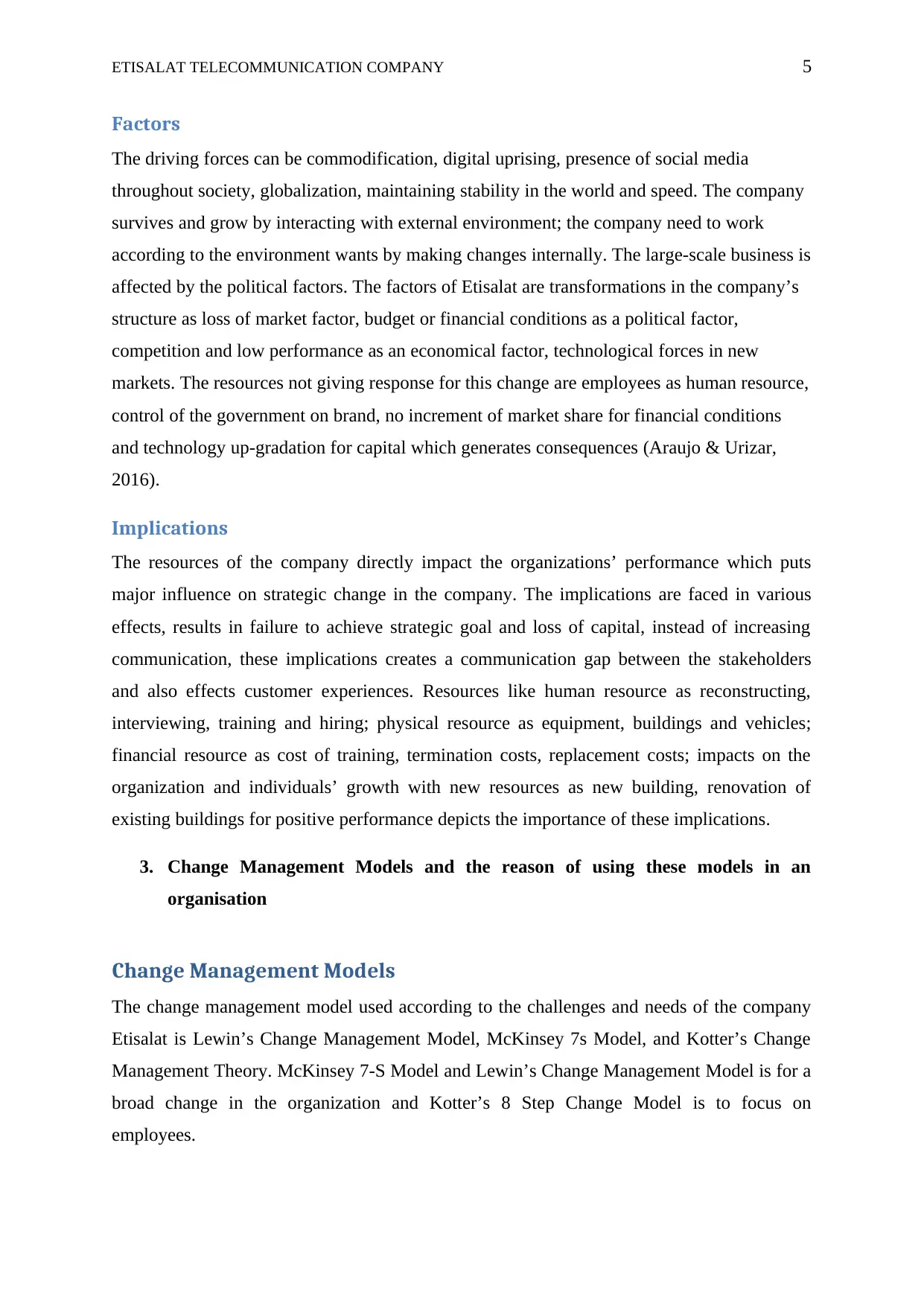
ETISALAT TELECOMMUNICATION COMPANY 5
Factors
The driving forces can be commodification, digital uprising, presence of social media
throughout society, globalization, maintaining stability in the world and speed. The company
survives and grow by interacting with external environment; the company need to work
according to the environment wants by making changes internally. The large-scale business is
affected by the political factors. The factors of Etisalat are transformations in the company’s
structure as loss of market factor, budget or financial conditions as a political factor,
competition and low performance as an economical factor, technological forces in new
markets. The resources not giving response for this change are employees as human resource,
control of the government on brand, no increment of market share for financial conditions
and technology up-gradation for capital which generates consequences (Araujo & Urizar,
2016).
Implications
The resources of the company directly impact the organizations’ performance which puts
major influence on strategic change in the company. The implications are faced in various
effects, results in failure to achieve strategic goal and loss of capital, instead of increasing
communication, these implications creates a communication gap between the stakeholders
and also effects customer experiences. Resources like human resource as reconstructing,
interviewing, training and hiring; physical resource as equipment, buildings and vehicles;
financial resource as cost of training, termination costs, replacement costs; impacts on the
organization and individuals’ growth with new resources as new building, renovation of
existing buildings for positive performance depicts the importance of these implications.
3. Change Management Models and the reason of using these models in an
organisation
Change Management Models
The change management model used according to the challenges and needs of the company
Etisalat is Lewin’s Change Management Model, McKinsey 7s Model, and Kotter’s Change
Management Theory. McKinsey 7-S Model and Lewin’s Change Management Model is for a
broad change in the organization and Kotter’s 8 Step Change Model is to focus on
employees.
Factors
The driving forces can be commodification, digital uprising, presence of social media
throughout society, globalization, maintaining stability in the world and speed. The company
survives and grow by interacting with external environment; the company need to work
according to the environment wants by making changes internally. The large-scale business is
affected by the political factors. The factors of Etisalat are transformations in the company’s
structure as loss of market factor, budget or financial conditions as a political factor,
competition and low performance as an economical factor, technological forces in new
markets. The resources not giving response for this change are employees as human resource,
control of the government on brand, no increment of market share for financial conditions
and technology up-gradation for capital which generates consequences (Araujo & Urizar,
2016).
Implications
The resources of the company directly impact the organizations’ performance which puts
major influence on strategic change in the company. The implications are faced in various
effects, results in failure to achieve strategic goal and loss of capital, instead of increasing
communication, these implications creates a communication gap between the stakeholders
and also effects customer experiences. Resources like human resource as reconstructing,
interviewing, training and hiring; physical resource as equipment, buildings and vehicles;
financial resource as cost of training, termination costs, replacement costs; impacts on the
organization and individuals’ growth with new resources as new building, renovation of
existing buildings for positive performance depicts the importance of these implications.
3. Change Management Models and the reason of using these models in an
organisation
Change Management Models
The change management model used according to the challenges and needs of the company
Etisalat is Lewin’s Change Management Model, McKinsey 7s Model, and Kotter’s Change
Management Theory. McKinsey 7-S Model and Lewin’s Change Management Model is for a
broad change in the organization and Kotter’s 8 Step Change Model is to focus on
employees.
⊘ This is a preview!⊘
Do you want full access?
Subscribe today to unlock all pages.

Trusted by 1+ million students worldwide
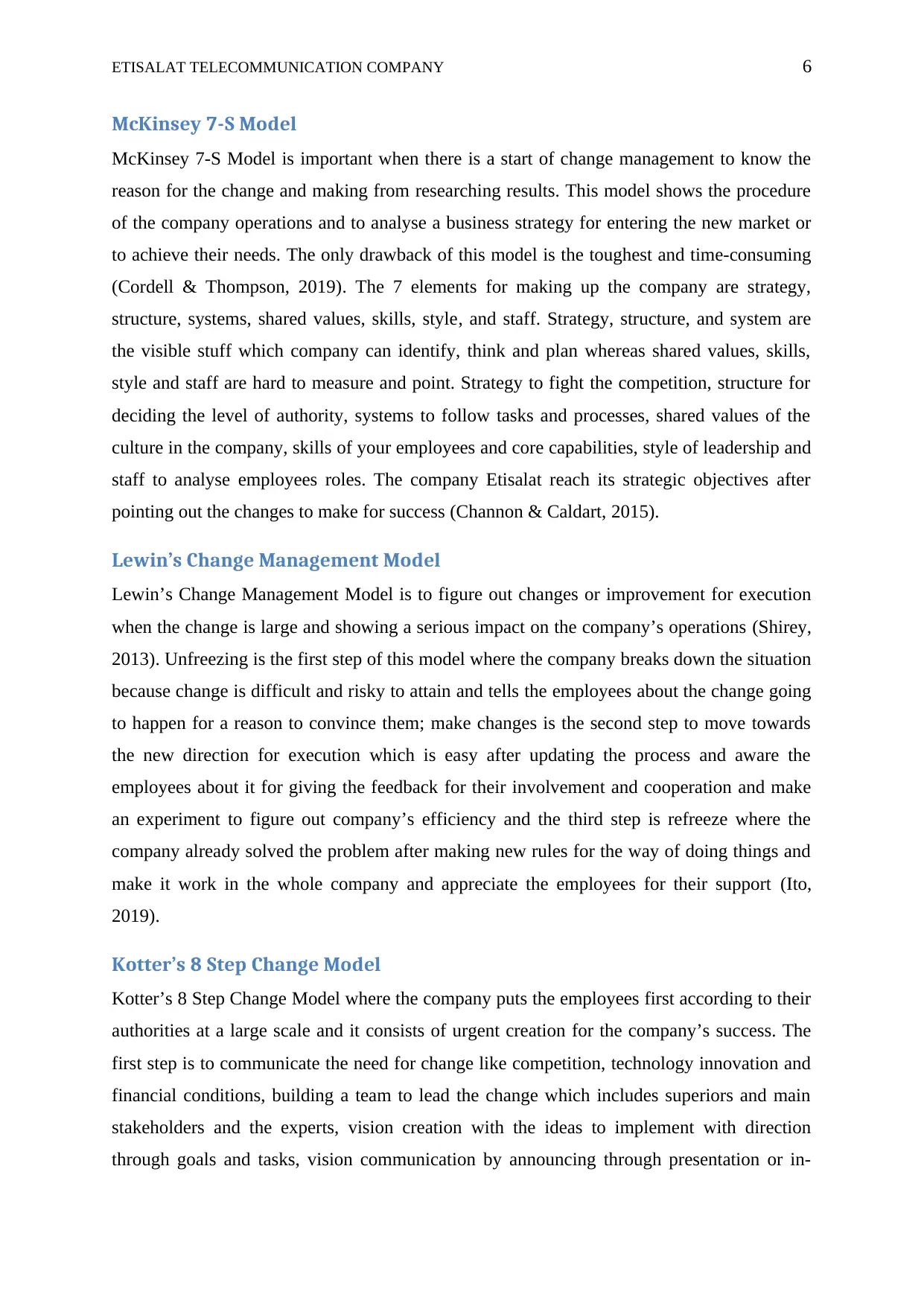
ETISALAT TELECOMMUNICATION COMPANY 6
McKinsey 7-S Model
McKinsey 7-S Model is important when there is a start of change management to know the
reason for the change and making from researching results. This model shows the procedure
of the company operations and to analyse a business strategy for entering the new market or
to achieve their needs. The only drawback of this model is the toughest and time-consuming
(Cordell & Thompson, 2019). The 7 elements for making up the company are strategy,
structure, systems, shared values, skills, style, and staff. Strategy, structure, and system are
the visible stuff which company can identify, think and plan whereas shared values, skills,
style and staff are hard to measure and point. Strategy to fight the competition, structure for
deciding the level of authority, systems to follow tasks and processes, shared values of the
culture in the company, skills of your employees and core capabilities, style of leadership and
staff to analyse employees roles. The company Etisalat reach its strategic objectives after
pointing out the changes to make for success (Channon & Caldart, 2015).
Lewin’s Change Management Model
Lewin’s Change Management Model is to figure out changes or improvement for execution
when the change is large and showing a serious impact on the company’s operations (Shirey,
2013). Unfreezing is the first step of this model where the company breaks down the situation
because change is difficult and risky to attain and tells the employees about the change going
to happen for a reason to convince them; make changes is the second step to move towards
the new direction for execution which is easy after updating the process and aware the
employees about it for giving the feedback for their involvement and cooperation and make
an experiment to figure out company’s efficiency and the third step is refreeze where the
company already solved the problem after making new rules for the way of doing things and
make it work in the whole company and appreciate the employees for their support (Ito,
2019).
Kotter’s 8 Step Change Model
Kotter’s 8 Step Change Model where the company puts the employees first according to their
authorities at a large scale and it consists of urgent creation for the company’s success. The
first step is to communicate the need for change like competition, technology innovation and
financial conditions, building a team to lead the change which includes superiors and main
stakeholders and the experts, vision creation with the ideas to implement with direction
through goals and tasks, vision communication by announcing through presentation or in-
McKinsey 7-S Model
McKinsey 7-S Model is important when there is a start of change management to know the
reason for the change and making from researching results. This model shows the procedure
of the company operations and to analyse a business strategy for entering the new market or
to achieve their needs. The only drawback of this model is the toughest and time-consuming
(Cordell & Thompson, 2019). The 7 elements for making up the company are strategy,
structure, systems, shared values, skills, style, and staff. Strategy, structure, and system are
the visible stuff which company can identify, think and plan whereas shared values, skills,
style and staff are hard to measure and point. Strategy to fight the competition, structure for
deciding the level of authority, systems to follow tasks and processes, shared values of the
culture in the company, skills of your employees and core capabilities, style of leadership and
staff to analyse employees roles. The company Etisalat reach its strategic objectives after
pointing out the changes to make for success (Channon & Caldart, 2015).
Lewin’s Change Management Model
Lewin’s Change Management Model is to figure out changes or improvement for execution
when the change is large and showing a serious impact on the company’s operations (Shirey,
2013). Unfreezing is the first step of this model where the company breaks down the situation
because change is difficult and risky to attain and tells the employees about the change going
to happen for a reason to convince them; make changes is the second step to move towards
the new direction for execution which is easy after updating the process and aware the
employees about it for giving the feedback for their involvement and cooperation and make
an experiment to figure out company’s efficiency and the third step is refreeze where the
company already solved the problem after making new rules for the way of doing things and
make it work in the whole company and appreciate the employees for their support (Ito,
2019).
Kotter’s 8 Step Change Model
Kotter’s 8 Step Change Model where the company puts the employees first according to their
authorities at a large scale and it consists of urgent creation for the company’s success. The
first step is to communicate the need for change like competition, technology innovation and
financial conditions, building a team to lead the change which includes superiors and main
stakeholders and the experts, vision creation with the ideas to implement with direction
through goals and tasks, vision communication by announcing through presentation or in-
Paraphrase This Document
Need a fresh take? Get an instant paraphrase of this document with our AI Paraphraser
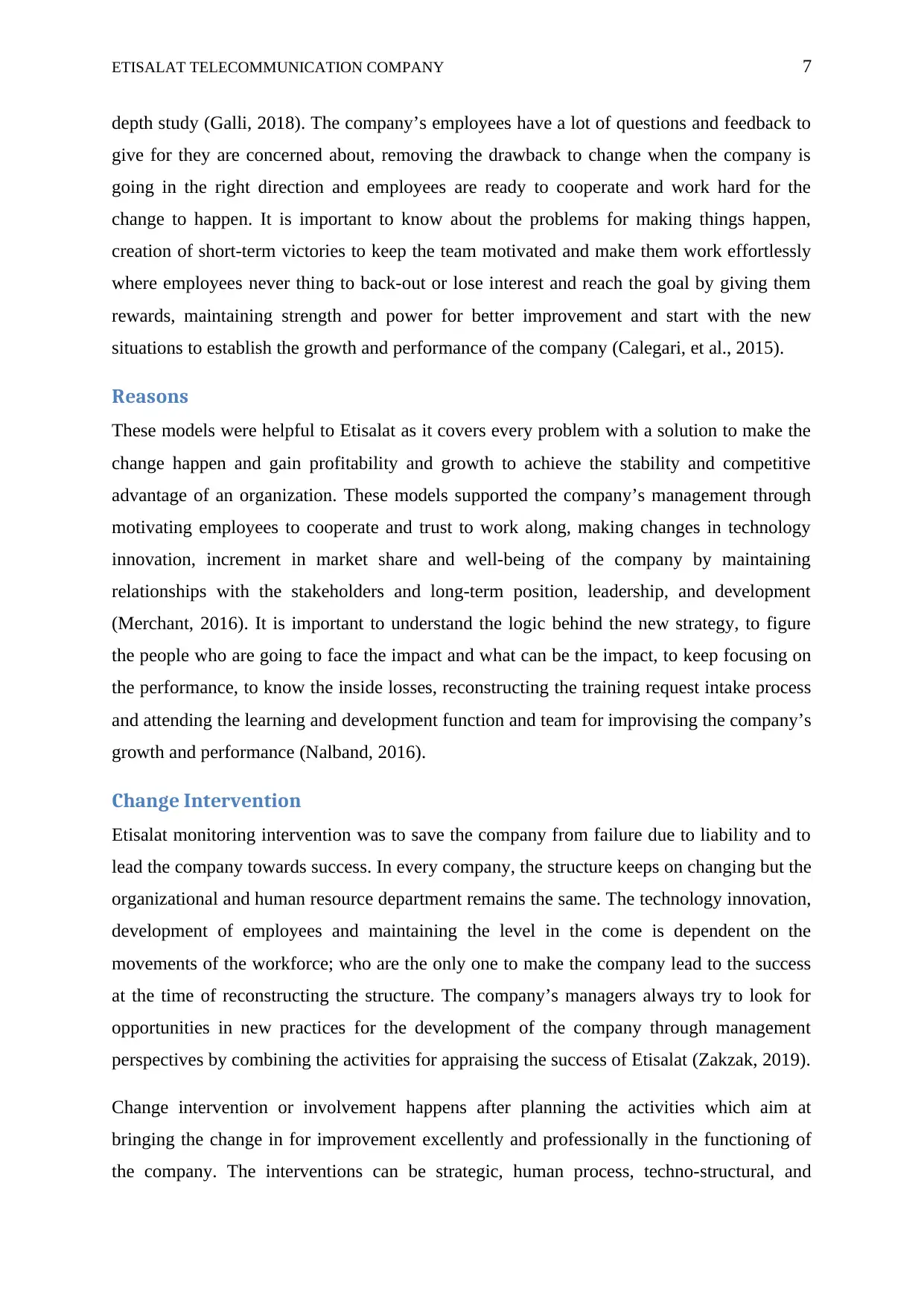
ETISALAT TELECOMMUNICATION COMPANY 7
depth study (Galli, 2018). The company’s employees have a lot of questions and feedback to
give for they are concerned about, removing the drawback to change when the company is
going in the right direction and employees are ready to cooperate and work hard for the
change to happen. It is important to know about the problems for making things happen,
creation of short-term victories to keep the team motivated and make them work effortlessly
where employees never thing to back-out or lose interest and reach the goal by giving them
rewards, maintaining strength and power for better improvement and start with the new
situations to establish the growth and performance of the company (Calegari, et al., 2015).
Reasons
These models were helpful to Etisalat as it covers every problem with a solution to make the
change happen and gain profitability and growth to achieve the stability and competitive
advantage of an organization. These models supported the company’s management through
motivating employees to cooperate and trust to work along, making changes in technology
innovation, increment in market share and well-being of the company by maintaining
relationships with the stakeholders and long-term position, leadership, and development
(Merchant, 2016). It is important to understand the logic behind the new strategy, to figure
the people who are going to face the impact and what can be the impact, to keep focusing on
the performance, to know the inside losses, reconstructing the training request intake process
and attending the learning and development function and team for improvising the company’s
growth and performance (Nalband, 2016).
Change Intervention
Etisalat monitoring intervention was to save the company from failure due to liability and to
lead the company towards success. In every company, the structure keeps on changing but the
organizational and human resource department remains the same. The technology innovation,
development of employees and maintaining the level in the come is dependent on the
movements of the workforce; who are the only one to make the company lead to the success
at the time of reconstructing the structure. The company’s managers always try to look for
opportunities in new practices for the development of the company through management
perspectives by combining the activities for appraising the success of Etisalat (Zakzak, 2019).
Change intervention or involvement happens after planning the activities which aim at
bringing the change in for improvement excellently and professionally in the functioning of
the company. The interventions can be strategic, human process, techno-structural, and
depth study (Galli, 2018). The company’s employees have a lot of questions and feedback to
give for they are concerned about, removing the drawback to change when the company is
going in the right direction and employees are ready to cooperate and work hard for the
change to happen. It is important to know about the problems for making things happen,
creation of short-term victories to keep the team motivated and make them work effortlessly
where employees never thing to back-out or lose interest and reach the goal by giving them
rewards, maintaining strength and power for better improvement and start with the new
situations to establish the growth and performance of the company (Calegari, et al., 2015).
Reasons
These models were helpful to Etisalat as it covers every problem with a solution to make the
change happen and gain profitability and growth to achieve the stability and competitive
advantage of an organization. These models supported the company’s management through
motivating employees to cooperate and trust to work along, making changes in technology
innovation, increment in market share and well-being of the company by maintaining
relationships with the stakeholders and long-term position, leadership, and development
(Merchant, 2016). It is important to understand the logic behind the new strategy, to figure
the people who are going to face the impact and what can be the impact, to keep focusing on
the performance, to know the inside losses, reconstructing the training request intake process
and attending the learning and development function and team for improvising the company’s
growth and performance (Nalband, 2016).
Change Intervention
Etisalat monitoring intervention was to save the company from failure due to liability and to
lead the company towards success. In every company, the structure keeps on changing but the
organizational and human resource department remains the same. The technology innovation,
development of employees and maintaining the level in the come is dependent on the
movements of the workforce; who are the only one to make the company lead to the success
at the time of reconstructing the structure. The company’s managers always try to look for
opportunities in new practices for the development of the company through management
perspectives by combining the activities for appraising the success of Etisalat (Zakzak, 2019).
Change intervention or involvement happens after planning the activities which aim at
bringing the change in for improvement excellently and professionally in the functioning of
the company. The interventions can be strategic, human process, techno-structural, and
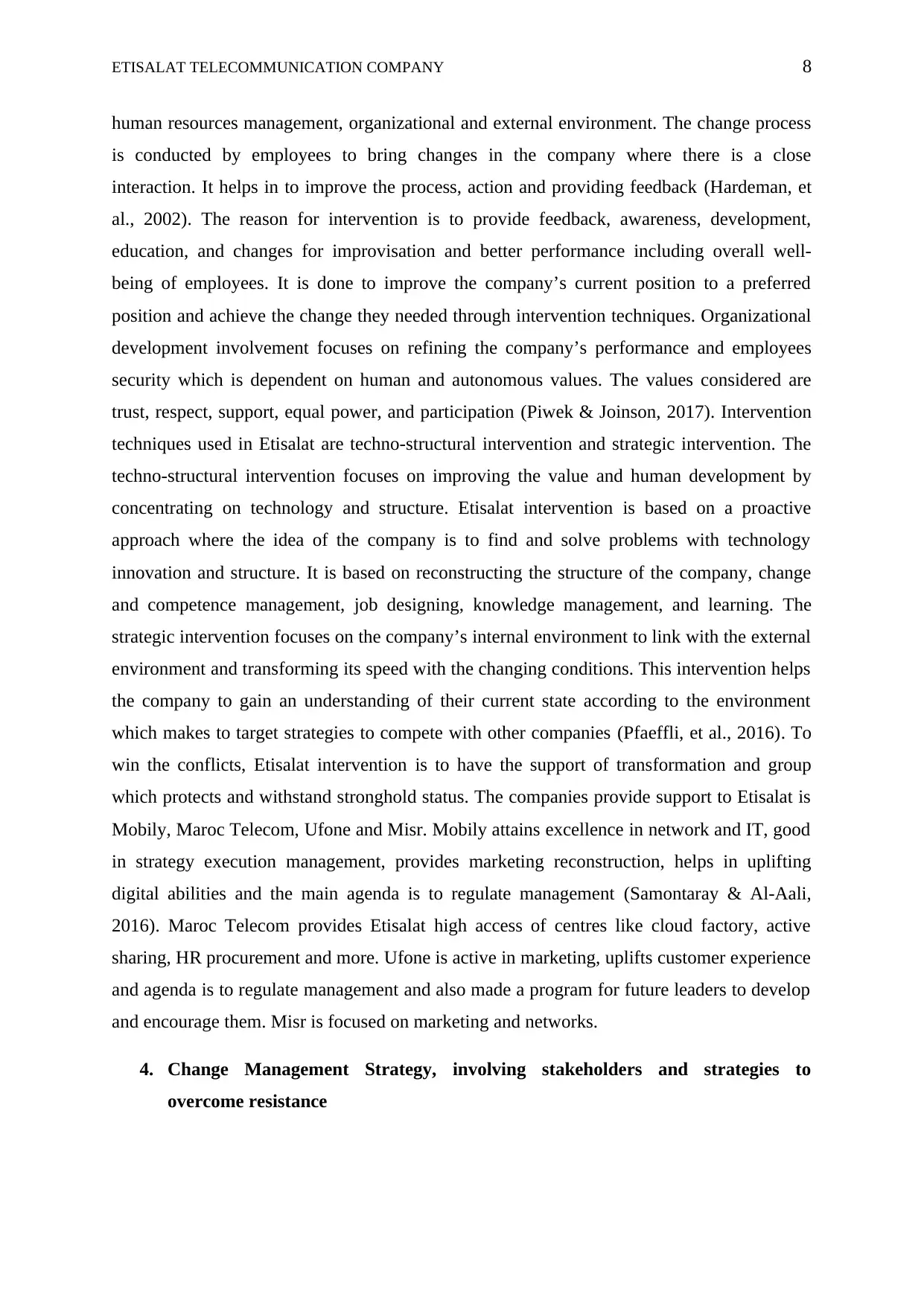
ETISALAT TELECOMMUNICATION COMPANY 8
human resources management, organizational and external environment. The change process
is conducted by employees to bring changes in the company where there is a close
interaction. It helps in to improve the process, action and providing feedback (Hardeman, et
al., 2002). The reason for intervention is to provide feedback, awareness, development,
education, and changes for improvisation and better performance including overall well-
being of employees. It is done to improve the company’s current position to a preferred
position and achieve the change they needed through intervention techniques. Organizational
development involvement focuses on refining the company’s performance and employees
security which is dependent on human and autonomous values. The values considered are
trust, respect, support, equal power, and participation (Piwek & Joinson, 2017). Intervention
techniques used in Etisalat are techno-structural intervention and strategic intervention. The
techno-structural intervention focuses on improving the value and human development by
concentrating on technology and structure. Etisalat intervention is based on a proactive
approach where the idea of the company is to find and solve problems with technology
innovation and structure. It is based on reconstructing the structure of the company, change
and competence management, job designing, knowledge management, and learning. The
strategic intervention focuses on the company’s internal environment to link with the external
environment and transforming its speed with the changing conditions. This intervention helps
the company to gain an understanding of their current state according to the environment
which makes to target strategies to compete with other companies (Pfaeffli, et al., 2016). To
win the conflicts, Etisalat intervention is to have the support of transformation and group
which protects and withstand stronghold status. The companies provide support to Etisalat is
Mobily, Maroc Telecom, Ufone and Misr. Mobily attains excellence in network and IT, good
in strategy execution management, provides marketing reconstruction, helps in uplifting
digital abilities and the main agenda is to regulate management (Samontaray & Al-Aali,
2016). Maroc Telecom provides Etisalat high access of centres like cloud factory, active
sharing, HR procurement and more. Ufone is active in marketing, uplifts customer experience
and agenda is to regulate management and also made a program for future leaders to develop
and encourage them. Misr is focused on marketing and networks.
4. Change Management Strategy, involving stakeholders and strategies to
overcome resistance
human resources management, organizational and external environment. The change process
is conducted by employees to bring changes in the company where there is a close
interaction. It helps in to improve the process, action and providing feedback (Hardeman, et
al., 2002). The reason for intervention is to provide feedback, awareness, development,
education, and changes for improvisation and better performance including overall well-
being of employees. It is done to improve the company’s current position to a preferred
position and achieve the change they needed through intervention techniques. Organizational
development involvement focuses on refining the company’s performance and employees
security which is dependent on human and autonomous values. The values considered are
trust, respect, support, equal power, and participation (Piwek & Joinson, 2017). Intervention
techniques used in Etisalat are techno-structural intervention and strategic intervention. The
techno-structural intervention focuses on improving the value and human development by
concentrating on technology and structure. Etisalat intervention is based on a proactive
approach where the idea of the company is to find and solve problems with technology
innovation and structure. It is based on reconstructing the structure of the company, change
and competence management, job designing, knowledge management, and learning. The
strategic intervention focuses on the company’s internal environment to link with the external
environment and transforming its speed with the changing conditions. This intervention helps
the company to gain an understanding of their current state according to the environment
which makes to target strategies to compete with other companies (Pfaeffli, et al., 2016). To
win the conflicts, Etisalat intervention is to have the support of transformation and group
which protects and withstand stronghold status. The companies provide support to Etisalat is
Mobily, Maroc Telecom, Ufone and Misr. Mobily attains excellence in network and IT, good
in strategy execution management, provides marketing reconstruction, helps in uplifting
digital abilities and the main agenda is to regulate management (Samontaray & Al-Aali,
2016). Maroc Telecom provides Etisalat high access of centres like cloud factory, active
sharing, HR procurement and more. Ufone is active in marketing, uplifts customer experience
and agenda is to regulate management and also made a program for future leaders to develop
and encourage them. Misr is focused on marketing and networks.
4. Change Management Strategy, involving stakeholders and strategies to
overcome resistance
⊘ This is a preview!⊘
Do you want full access?
Subscribe today to unlock all pages.

Trusted by 1+ million students worldwide
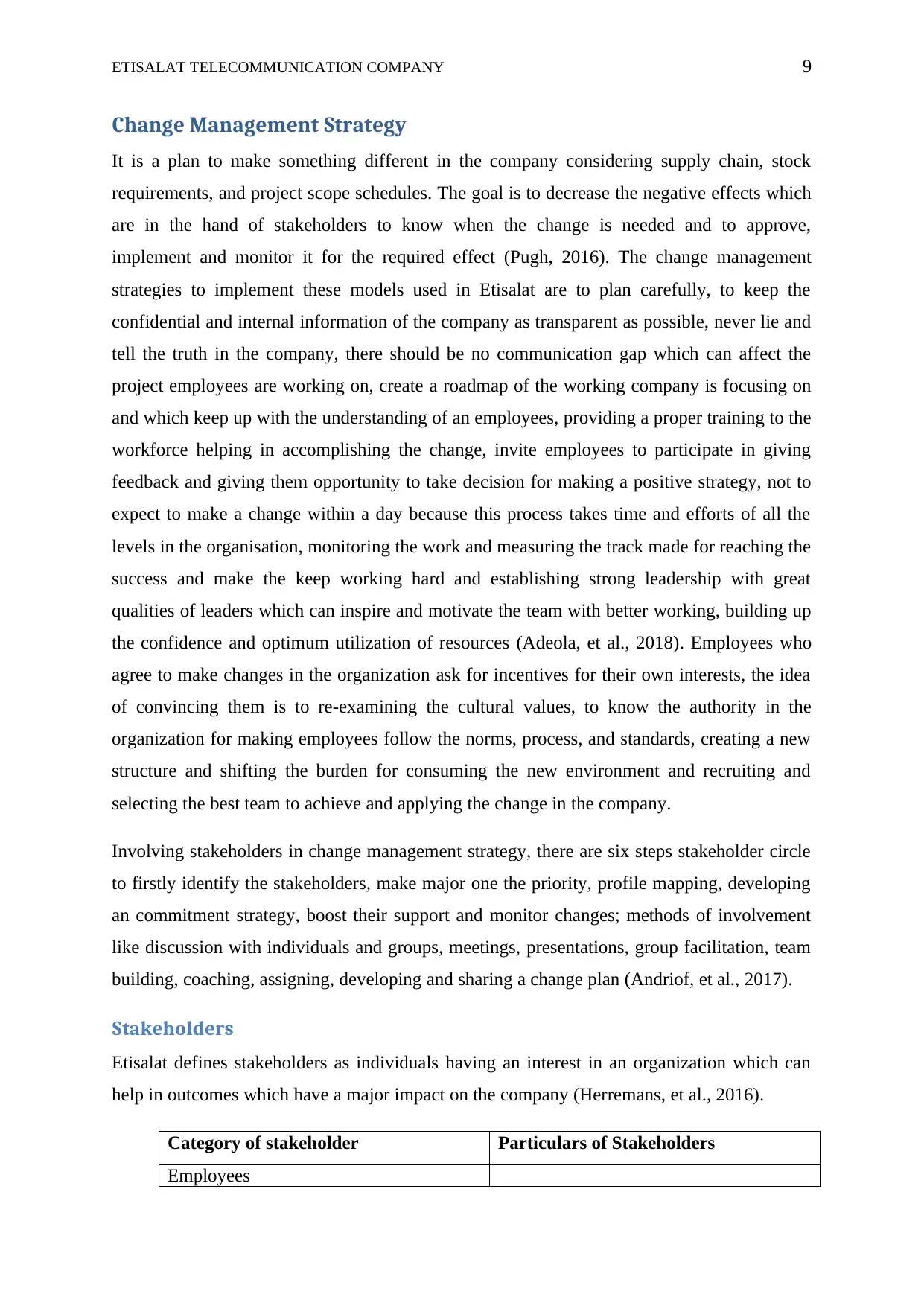
ETISALAT TELECOMMUNICATION COMPANY 9
Change Management Strategy
It is a plan to make something different in the company considering supply chain, stock
requirements, and project scope schedules. The goal is to decrease the negative effects which
are in the hand of stakeholders to know when the change is needed and to approve,
implement and monitor it for the required effect (Pugh, 2016). The change management
strategies to implement these models used in Etisalat are to plan carefully, to keep the
confidential and internal information of the company as transparent as possible, never lie and
tell the truth in the company, there should be no communication gap which can affect the
project employees are working on, create a roadmap of the working company is focusing on
and which keep up with the understanding of an employees, providing a proper training to the
workforce helping in accomplishing the change, invite employees to participate in giving
feedback and giving them opportunity to take decision for making a positive strategy, not to
expect to make a change within a day because this process takes time and efforts of all the
levels in the organisation, monitoring the work and measuring the track made for reaching the
success and make the keep working hard and establishing strong leadership with great
qualities of leaders which can inspire and motivate the team with better working, building up
the confidence and optimum utilization of resources (Adeola, et al., 2018). Employees who
agree to make changes in the organization ask for incentives for their own interests, the idea
of convincing them is to re-examining the cultural values, to know the authority in the
organization for making employees follow the norms, process, and standards, creating a new
structure and shifting the burden for consuming the new environment and recruiting and
selecting the best team to achieve and applying the change in the company.
Involving stakeholders in change management strategy, there are six steps stakeholder circle
to firstly identify the stakeholders, make major one the priority, profile mapping, developing
an commitment strategy, boost their support and monitor changes; methods of involvement
like discussion with individuals and groups, meetings, presentations, group facilitation, team
building, coaching, assigning, developing and sharing a change plan (Andriof, et al., 2017).
Stakeholders
Etisalat defines stakeholders as individuals having an interest in an organization which can
help in outcomes which have a major impact on the company (Herremans, et al., 2016).
Category of stakeholder Particulars of Stakeholders
Employees
Change Management Strategy
It is a plan to make something different in the company considering supply chain, stock
requirements, and project scope schedules. The goal is to decrease the negative effects which
are in the hand of stakeholders to know when the change is needed and to approve,
implement and monitor it for the required effect (Pugh, 2016). The change management
strategies to implement these models used in Etisalat are to plan carefully, to keep the
confidential and internal information of the company as transparent as possible, never lie and
tell the truth in the company, there should be no communication gap which can affect the
project employees are working on, create a roadmap of the working company is focusing on
and which keep up with the understanding of an employees, providing a proper training to the
workforce helping in accomplishing the change, invite employees to participate in giving
feedback and giving them opportunity to take decision for making a positive strategy, not to
expect to make a change within a day because this process takes time and efforts of all the
levels in the organisation, monitoring the work and measuring the track made for reaching the
success and make the keep working hard and establishing strong leadership with great
qualities of leaders which can inspire and motivate the team with better working, building up
the confidence and optimum utilization of resources (Adeola, et al., 2018). Employees who
agree to make changes in the organization ask for incentives for their own interests, the idea
of convincing them is to re-examining the cultural values, to know the authority in the
organization for making employees follow the norms, process, and standards, creating a new
structure and shifting the burden for consuming the new environment and recruiting and
selecting the best team to achieve and applying the change in the company.
Involving stakeholders in change management strategy, there are six steps stakeholder circle
to firstly identify the stakeholders, make major one the priority, profile mapping, developing
an commitment strategy, boost their support and monitor changes; methods of involvement
like discussion with individuals and groups, meetings, presentations, group facilitation, team
building, coaching, assigning, developing and sharing a change plan (Andriof, et al., 2017).
Stakeholders
Etisalat defines stakeholders as individuals having an interest in an organization which can
help in outcomes which have a major impact on the company (Herremans, et al., 2016).
Category of stakeholder Particulars of Stakeholders
Employees
Paraphrase This Document
Need a fresh take? Get an instant paraphrase of this document with our AI Paraphraser
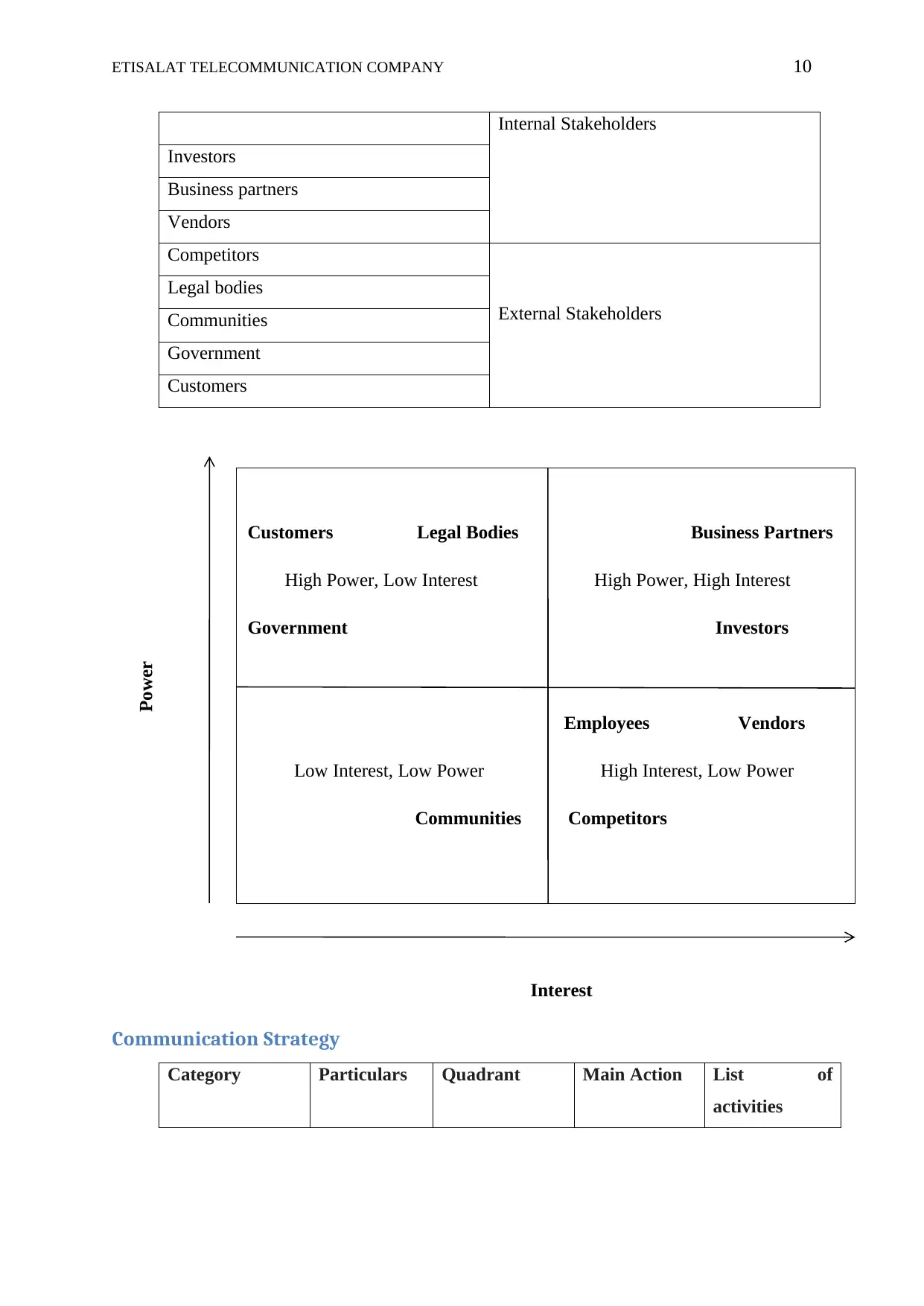
ETISALAT TELECOMMUNICATION COMPANY 10
Internal Stakeholders
Investors
Business partners
Vendors
Competitors
External Stakeholders
Legal bodies
Communities
Government
Customers
Interest
Communication Strategy
Category Particulars Quadrant Main Action List of
activities
Customers Legal Bodies Business Partners
High Power, Low Interest High Power, High Interest
Government Investors
Employees Vendors
Low Interest, Low Power High Interest, Low Power
Communities Competitors
Power
Internal Stakeholders
Investors
Business partners
Vendors
Competitors
External Stakeholders
Legal bodies
Communities
Government
Customers
Interest
Communication Strategy
Category Particulars Quadrant Main Action List of
activities
Customers Legal Bodies Business Partners
High Power, Low Interest High Power, High Interest
Government Investors
Employees Vendors
Low Interest, Low Power High Interest, Low Power
Communities Competitors
Power
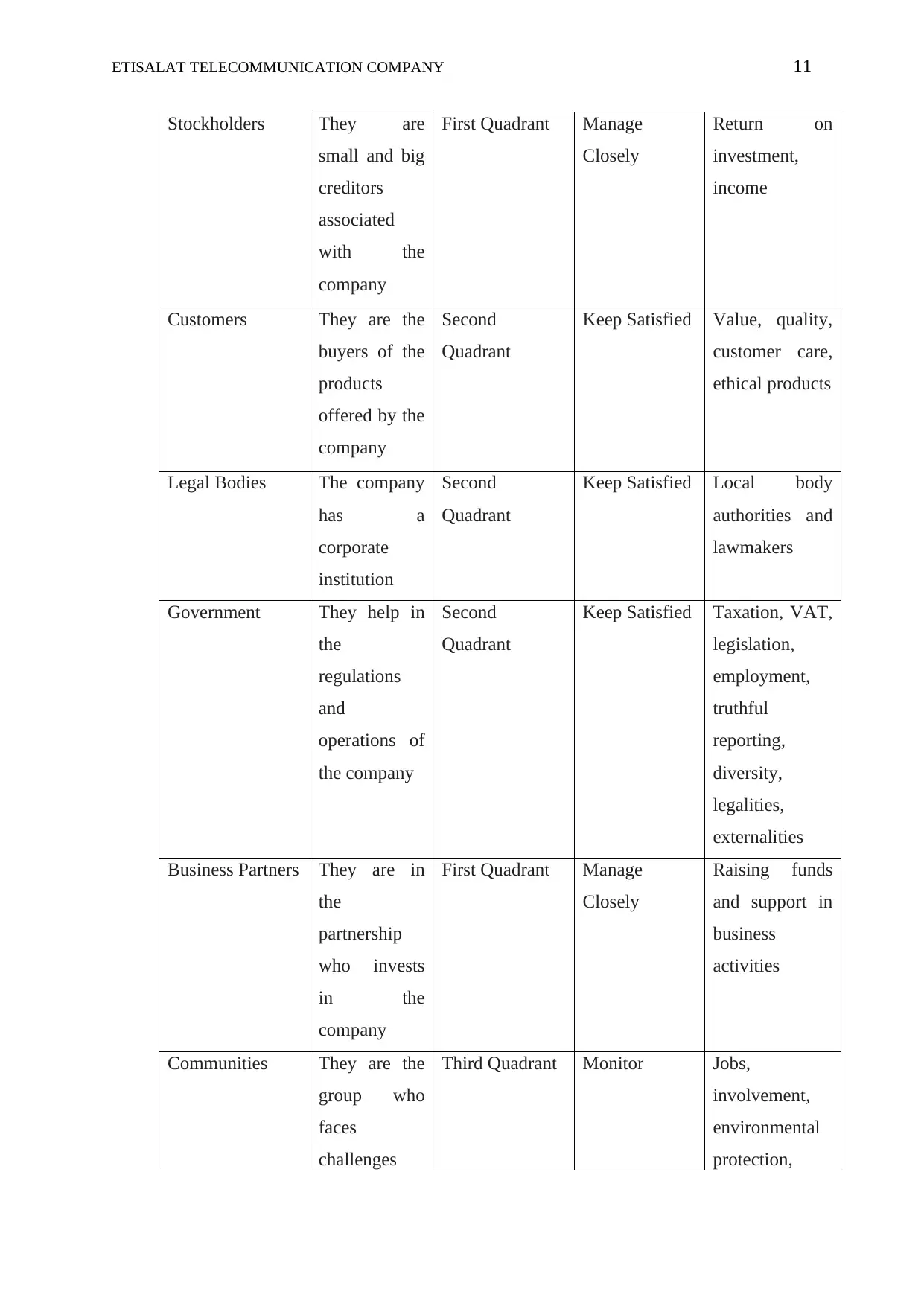
ETISALAT TELECOMMUNICATION COMPANY 11
Stockholders They are
small and big
creditors
associated
with the
company
First Quadrant Manage
Closely
Return on
investment,
income
Customers They are the
buyers of the
products
offered by the
company
Second
Quadrant
Keep Satisfied Value, quality,
customer care,
ethical products
Legal Bodies The company
has a
corporate
institution
Second
Quadrant
Keep Satisfied Local body
authorities and
lawmakers
Government They help in
the
regulations
and
operations of
the company
Second
Quadrant
Keep Satisfied Taxation, VAT,
legislation,
employment,
truthful
reporting,
diversity,
legalities,
externalities
Business Partners They are in
the
partnership
who invests
in the
company
First Quadrant Manage
Closely
Raising funds
and support in
business
activities
Communities They are the
group who
faces
challenges
Third Quadrant Monitor Jobs,
involvement,
environmental
protection,
Stockholders They are
small and big
creditors
associated
with the
company
First Quadrant Manage
Closely
Return on
investment,
income
Customers They are the
buyers of the
products
offered by the
company
Second
Quadrant
Keep Satisfied Value, quality,
customer care,
ethical products
Legal Bodies The company
has a
corporate
institution
Second
Quadrant
Keep Satisfied Local body
authorities and
lawmakers
Government They help in
the
regulations
and
operations of
the company
Second
Quadrant
Keep Satisfied Taxation, VAT,
legislation,
employment,
truthful
reporting,
diversity,
legalities,
externalities
Business Partners They are in
the
partnership
who invests
in the
company
First Quadrant Manage
Closely
Raising funds
and support in
business
activities
Communities They are the
group who
faces
challenges
Third Quadrant Monitor Jobs,
involvement,
environmental
protection,
⊘ This is a preview!⊘
Do you want full access?
Subscribe today to unlock all pages.

Trusted by 1+ million students worldwide
1 out of 23
Related Documents
Your All-in-One AI-Powered Toolkit for Academic Success.
+13062052269
info@desklib.com
Available 24*7 on WhatsApp / Email
![[object Object]](/_next/static/media/star-bottom.7253800d.svg)
Unlock your academic potential
Copyright © 2020–2025 A2Z Services. All Rights Reserved. Developed and managed by ZUCOL.




